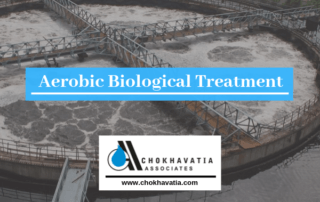What is Aerobic Biological Treatment?
What is Aerobic Biological Treatment?
Water contains two part of hydrogen and one part of oxygen. However, this combination is not true in case of waste water as it does not contain only hydrogen and oxygen, but there are many other substances that are dissolved in it – some are seen and some are unseen. These substances are called “IMPURITIES”. When water is consumed by human being, these substances are added in it, and we call it waste water or sewage water, which is usually released in the environment. The term sewage is more commonly used to describe the waste coming out of residential and commercial complexes and waste water coming out of industrial complexes is often described as effluent.
When we talk about effluent or industrial waste water, the nature of impurities is so dangerous that the waste cannot be released in environment without treatment. This is when waste water treatment comes into picture. Over the years, due to the high amount of impurities in industrial and commercial waste water, a number of technologies have been developed to treat the water in the best possible manner. These technologies are categorized into several segments such as Physical, Chemical and Biological. The biological treatment method is further categorized in two types i.e. Aerobic Biological Treatment and Anaerobic Biological Treatment.
Aerobic Biological Treatment is mostly used to eliminate organic impurities. Organic substances are those that contain carbon from devastated material such as vegetable, papers, grease, etc. Inorganic substances are those that do not contain carbon such as metals, acids, salts, etc. Refineries, Chemical & Petrochemical units, fertilizers, and textile sector are some of the sector that put high emphasis on effluent treatment plants as waste water coming out of these complexes are highly impure and causes threat to the environment. Aerobic Biological Treatment is an unavoidable part of Effluent Treatment Plants set up in these industries.
Types of Aerobic Biological Treatment
Now even under Aerobic Biological Treatment, several steps or methods are practiced across the world, which typically includes Conventional Activated Sludge Process (ASP) System, Cyclic Activated Sludge System, Integrated Fixed Film Activated Sludge (IFAS) System and Membrane Bioreactor.
- Activated Sludge Process is the most old and most common method, which, after the primary treatment, is used to treat both municipal sewage and industrial waste water. It is basically used to decompose the organic impurities by utilizing microorganisms such as bacteria, fungi, rotifers and protozoa. In other words, it converts the waste into CO2, which can be released in the environment.
- On the other hand, Cyclic Activated Sludge System enables treatment of a variety of water impurity with the help of a single variable volume basin and does not require the final clarifiers. Cyclic Activated Sludge System is much cheaper, flexible, reliable and effective.
- Integrated Fixed Film Activated Sludge (IFAS) System is one of the latest Aerobic Biological Treatment methods that allow multiple stages of biological treatment in an integrated manner.
- Membrane Bioreactor is undoubtedly THE LATEST technology to degrade organic impurities in water. It is widely used for treating sewage water for internal water application within an industry.
Chokhavatia Associates are pioneers in designing the Water Treatment Plants for different types of waste water generating effluents and its applications. We have successfully designed and commissioned Activated sludge Plants for various industries like sugar, soap, solvent and oil extraction industries, edible oil refineries, food, dairy, soft drink bottling, breweries, starch, pesticides

